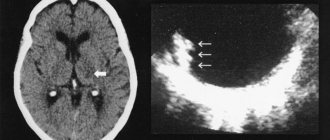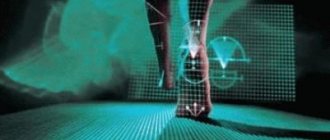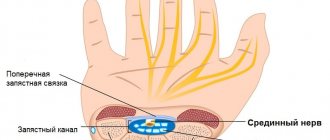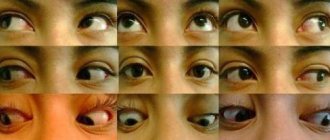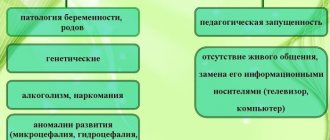The largest nerve of the body (sciatic), when its pathology develops or is damaged, brings a lot of trouble to its owner, especially if the person is over 40 years old.
Most often, this category of people complains of pain in the area of the sciatic nerve, which stretches from the lower leg to the lower back, passing under the knees and ending in the heels, and often with a cold, all the fibers that make up the sciatic nerve hurt.
Signs of a cold in the sciatic nerve will be noticeable to any person, because they always have a pronounced painful expression. First, the lower back may hurt, then the pain will spread lower, right down to the surface of the feet along the back of the legs.
Often in this situation, a person cannot move independently.
What to do if you have a cold in your back
If a person has a cold in the back, first of all it is necessary to reduce body movements to a minimum and, if possible, ensure complete rest by insulating the affected area. Limiting your movements will help your back muscles relax. As a rule, a cold back can be cured in 7-10 days, but therapy must be selected individually and agreed with a doctor.
Let's consider what to do if your back is blown in the area of the shoulder blades. First, you should make sure that the cause of the pain is hypothermia, and not a more serious illness (for example, a herniated disc). To do this, it is recommended to seek help from a specialist.
First aid for myositis
Myositis is an inflammation of the skeletal muscles, accompanied by severe pain. In the event that the area of the spinal column is slightly blown, therapy can be carried out at home. To avoid the progression of inflammation, when the first symptoms appear, it is recommended to adhere to the following recommendations:
- observe bed rest for the period of treatment so that the muscles are in a relaxed state, avoid any physical activity;
- do not turn on the air conditioner, avoid cold air and drafts, since hypothermia is prohibited;
- the affected area must be smeared with warming and anti-inflammatory ointments. They will help relieve muscle spasms and eliminate pain;
- if a person has a cold in his back muscles, he should not take hot baths during the treatment period, as this will cause greater pain;
- a special diet for myositis has not been established, but doctors note that the patient needs to drink plenty of fluids and eat foods that contain beneficial microelements and vitamins A, C and E. These include: vegetables (peppers and tomatoes), fruits (mainly citrus fruits) , meat (beef and chicken), fish (trout and tuna).
Drug treatment
When there is pain in the back, treatment should be prescribed by a doctor. The main step on the road to recovery is taking medications. In order to relieve the inflammatory process, the patient is prescribed non-steroidal anti-inflammatory drugs, such as diclofenac, movalis or ibuprofen. It is more advisable to use them in the form of injections
.
If the patient is suffering from severe sharp pain, the doctor may prescribe painkillers, for example, spasmalgon. Provided that the muscle spasm is very strong, various muscle relaxants can be used simultaneously with anti-inflammatory drugs. Any medications and their dose are prescribed by a specialist, since they have a number of contraindications and must be selected individually.
Rubs and ointments
Local medications are highly effective when a person has a cold in the area of the shoulder blades or lower back.
When you have a cold back, the best ointment for relieving pain should also have a warming effect. This could be, for example, finalgon or apisatron.
In addition to drug treatment, body rubs can be performed. For ½ teaspoon of medicinal powder, take 2 teaspoons of melted butter. The resulting mixture is gently rubbed into the painful area and wrapped with a warm cloth. For greater effect, it is recommended to wear a special belt, for example, made of sheep’s wool, after rubbing and applying ointments.
If you have a cold back, gels and creams with an anti-inflammatory effect are recommended to be used from the first day of the disease. They will help relieve swelling and pain in the affected area in a short time. These include: ketonal gel, fastum gel and voltaren emulgel.
Video
Video - blown back: how to treat it at home?
Physiotherapy
I answer the popular question: “how to quickly cure a blown lower back?” The recovery period depends entirely on the effectiveness of the treatment. In order to quickly cure your back (in 5-7 days), it is important to regularly carry out all procedures prescribed by a specialist.
If you have a cold in your lower back, a physiotherapist may prescribe the following procedures: electrophoresis, reflexology and acupuncture. They act on the source of inflammation, help improve blood circulation, normalize metabolic processes and do not cause allergic reactions. The main contraindication to physiotherapeutic treatment is elevated body temperature.
Basic exercises for treating your back at home:
- Lying on your back (on a hard, but not cold surface), bend your knees, keeping your feet on the floor. One by one, bend to the left and to the right, without lifting your back from the floor. Repeat 10-20 times.
- Get on all fours in a cat pose (palms and arms resting on the floor). One by one, round and bend your back for 30-60 seconds.
- Lie in the “child” pose (chest pressed to your knees, arms extended forward) for a few seconds.
Traditional methods
Let's take a closer look at how to treat a cold back at home:
- Compress made from white cabbage leaves. A cabbage leaf is smeared with honey and applied to the damaged area, tightly wrapped in gauze. For a stronger warming effect, you can add horseradish or mustard (in equal quantities), but in this case you should monitor your skin and remove the compress at the first negative sensations.
- Potato compress. To make a compress, you will need to take warm mashed potatoes (until puree), place them on gauze or other cotton cloth and apply them to the painful area, wrapping them in a warm cloth.
- Alcohol compress. Using alcohol for a compress improves blood circulation, which allows nutrients to quickly penetrate damaged tissue. An alternative to ethyl alcohol is pepper tincture or pure vodka. The product is applied to the skin, wrapped in cling film and insulated with a scarf.
- Vegetable oil. As an alternative, you can take fat; badger and goat fat are considered the most suitable.
To avoid burns, it is not recommended to keep the hot compress for longer than 6 hours. After applying compresses, the skin should be thoroughly rinsed with running water and water. Traditional medicine for myositis has a positive effect in combination with traditional methods.
Diagnostics
Due to the fact that after blowing your back the symptoms are very easy to confuse with other diseases, you should seek medical help. A neurologist, rheumatologist, or physiotherapist can help.
First you need to contact a therapist, who, after an initial examination, establishes a preliminary diagnosis. The required diagnostic scope, if in the near future the patient has a strong wind, and then pain in the back appears, includes:
- General blood analysis.
- General urine analysis.
- Biochemical blood test (determine the content of glucose, C-reactive protein - to look for differences from inflammatory diseases of the spine and systemic muscle diseases).
- Electromyography (determining the state of the nerves that regulate the functioning of the affected back muscles).
- MRI (magnetic resonance imaging) and CT (computed tomography).
- Ultrasound of the pelvic organs (genitourinary system).
- Gynecologist examination for women.
The list of tests and procedures can be expanded by the doctor if the patient has concomitant diseases of any organ system. For example, if a person suffers from characteristic pain and has previously had his back and lumbar region blown, an ultrasound of the kidneys and urine culture are indicated, because it may be acute pyelonephritis.
You need rest in the first days and warming procedures.
If your back is not too cold, then treatment at home includes the following methods: the use of traditional methods, drug treatment, physical exercise, physical therapy (procedures that warm up the muscles).
What to do if you have a cold back?
- Bed rest should be observed for 3-4 days, especially on the first day. The bed should not be too soft, sagging under the weight of the body. A special orthopedic mattress is ideal. The lying position will help the muscle fibers relax, stretch a little, and “calm down.”
- Use warming ointments and creams. Before use, you should carefully read the instructions and take into account contraindications. Ointments have worse penetrating ability, so it is better to use gels. As soon as the gel is applied to the back muscles, you should wear a warming belt or wrap a warm scarf.
- Limit yourself in taking excess fluid and salt, which lead to swelling of the muscles and subcutaneous tissue. Adding salt to food is completely eliminated.
- Diet varied with foods rich in B vitamins: all types of nuts (walnuts, hazelnuts, pistachios, etc.), liver, sea buckthorn, beans, peas, garlic, buckwheat, barley, oatmeal, millet, tuna, mackerel, egg, cottage cheese , cheese.
What not to do - how to avoid complications
If a person has a cold in the lower back, he needs to quickly return home and follow all first aid measures: complete rest, lack of physical activity, treatment with non-steroidal anti-inflammatory drugs. Neglecting these manipulations can negatively affect your health.
In the acute stage of the disease, you should limit yourself to taking a hot bath and visiting the sauna, since these manipulations contribute to the progression of the inflammatory process. If a girl has a cold in her back and nothing helps to relieve the inflammation on her own, it is recommended to consult a doctor as soon as possible. If treatment is ineffective, the disease can progress and become chronic.
5460 0
Human nature is such that most people treat their health completely irresponsibly until the body begins to give signals about problems with the help of. And when the pain goes away, they forget about it.
It turns out to be a vicious circle. Hypothermia and poor lifestyle have a direct impact on back health.
If there is a pain in your back, there will be pain, which will make it difficult to straighten up. Paradoxically, only then does a person begin to think about how to maintain health.
But this pathology can be prevented, but you begin to think about preventive measures only after characteristic complications arise.
The common people often say that “the back is cold,” and almost everyone is faced with the question of what to do if the lower back is cold. In modern medicine, this disease is treated in quick and effective ways, but you can also use traditional methods.
Doctors call this condition either (or and).
The diagnosis will be made in accordance with the nature and degree of localization of the inflammatory process.
What could be causing this problem?
The main reason that leads to pain is exposure to cold air masses.
You can get sick at any time of the year, but it is more likely to blow out your lower back in the summer.
What leads to hypothermia:
Therefore, you need to dress warmly for training, and after finishing it, quickly go home to take a shower and put on dry clothes.
These reasons lead to the fact that the muscles are initially well warmed up, the blood vessels are dilated and blood circulation is increased, but upon contact with cooler air or a change in temperature, spasms occur.
There are other mechanisms by which you can get a cold in your back, but the main cause is hypothermia.
Therefore, it is important to remember this, and if the workplace is located near an air conditioner, the temperature mode must be set correctly.
How to determine if there is pain in the lower back
Symptoms of a blown back will not appear immediately, but only ten hours after severe hypothermia.
The disease is characterized by both a single symptom and several signs.
Among them:
- the occurrence of severe pain in the lower back or back, especially during extension;
- it becomes more difficult to move;
- burning in the lumbar region;
- urination becomes more frequent;
- the skin takes on a bluish tint;
- changes in the menstrual cycle;
- soreness in the buttocks and legs;
- forced to take a bent position;
- when the inflammation process develops rapidly, there is a possibility of an increase in temperature.
Characteristic symptoms may appear one at a time or all together, and the patient’s condition may either worsen or improve. It all depends on the degree of pathology.
You should know that when your back is sore, the risk of developing inflammation of chronic diseases, for example, the kidneys, increases.
In this regard, in order for the consequences to be less serious, therapy should be prescribed as early as possible.
Inflammation of the spinal muscles is an inflammatory process in the muscle fibers, during which nodules form within the muscles.
In medicine, this disease is known by the term.
Symptoms of myositis include: pain on movement and palpation, muscle pain and atrophy, the skin becomes swollen and redness is observed.
What can cause myositis:
- infections;
- helminths;
- muscle cramps;
- hypothermia;
- muscle strain;
- influence of toxic substances.
Therapy for myositis is prescribed strictly on an individual basis, depending on what caused the inflammatory process.
Cold in the lower back: symptoms of the disease
The most important manifestation of this ailment is pain. They can have different character and intensity. In some cases, people feel a nagging pain in the lower back, due to which they are unable to even move freely. Sometimes patients feel pain that spreads to other muscles, up to the legs. Sometimes it is so strong that the cold muscles become numb.
Also, one of the main symptoms is increased urination and discoloration of the skin in the lumbar region. Sometimes the symptoms of a cold lower back in women are menstrual irregularities. If you neglect to treat a common muscle cold, it can cause the development of serious diseases, some of which are described in this article.
First aid
If the back pain is minor, therapy can be carried out at home.
The main thing is to start everything in a timely manner, then it will be possible to avoid the protracted nature of the disease.
You also need:
- if you have a cold in your back muscles, you should dress warmly before going outside;
- take painkillers if prescribed by a doctor;
- to avoid increased pain, do not take a hot bath;
- do physical therapy and relaxing massage;
- following a diet that involves excluding alcoholic beverages, fatty and salty foods, as well as fried and spicy foods.
Physiotherapy
Once the “acute” period has passed and the pain has subsided, physiotherapy is applicable - a method using natural factors for medicinal purposes. It has a lot of advantages: it does not cause allergies, enhances metabolism and renewal in tissues, improves blood flow and the body’s immune response. You can go through the following procedures:
- Massage (
general using movements such as rubbing, vibration and stroking, as well as local pressure on certain points of the body). - Myostimulation
(“training” muscles with electrical impulses). - Reflexology
: Transcutaneous electrical stimulation (electrical impulses block pain signals from nerves). - Acupuncture (treatment of an organ by needle stimulation of points on the body).
- Electroacupuncture (the principle is the same as described above, but the effect of current is added).
(delivery of drugs into the body using ultrasound).
(penetration of anti-inflammatory drugs into tissues using small electrical impulses from a device).
Myositis of the back muscles, as a rule, responds quickly to treatment and the chronic stage rarely occurs. If you follow the doctor’s recommendations, carry out the full course of therapy and do not make mistakes when treating at home, there will be no complications.
Traditional methods of treatment
When it is not possible to visit a doctor or go to a pharmacy, you can use traditional methods of treating a cold lower back. But it would be better to use them together with the medical recommendations described above.
Let's consider traditional therapy options:
- In cases where the lower back, back or neck are cold or cold, you can use an alcohol-based warming compress
. You can also use vodka or pepper tincture. The compress should be applied to the cold area, secured with film and insulated with something. For a good effect, it should be left overnight. This method helps improve blood supply, so nutrients quickly reach damaged areas of tissue. - Mustard plasters, a heating pad, or bags of heated salt can be applied to painful parts of the body
, which helps resolve swelling and bruises. - If there are cracks or damage to the skin, it is necessary to make a bandage with an antiseptic substance
(septocide, furatsilin and others). - You can use honey
, which should be well lubricated with a cabbage leaf and applied to the sore spot. To achieve the effect faster, you can add mustard or horseradish to honey. - rub fir oil
into the cold area along with pepper tincture, which you can make yourself or purchase at the pharmacy.
After the pain goes away, you can return to physical activity. But it is very important to “listen” to the condition of your back.
If there is no pain, you can visit the pool.
This is not only pleasant, but also useful. Swimming helps improve the muscular framework of the back. And if you exercise regularly, the likelihood of myalgia will be significantly reduced.
Set of exercises
It is useful to perform physical therapy at home. Preventative exercises help relieve pain.
Set of exercises:
- you need to lie on your back and bend your knees, your feet should be on the floor;
- the knees should be tilted in turn in different directions;
- your back should be pressed to the floor;
- the exercise must be repeated thirty times;
- after this, it is useful to take a warm shower and perform a warm back massage.
When you cannot cure yourself, you need to see a doctor and do not delay the visit. Painkillers and necessary examinations will be prescribed to make it possible to find out what is the cause of myalgia. It is very important to start treatment on time, otherwise there will be complications.
If myositis is not treated for a long time, more muscle groups will be involved in the inflammation process, which will subsequently atrophy.
How to avoid complications
It is better to prevent any disease than to treat it for a long time. Therefore, to prevent back problems from bothering you, you must adhere to the following tips:
Also, in methods of prevention, as well as for medicinal purposes, you can wear special belts that are made of sheep, dog or camel wool.
It doesn't take long for your back to show through. And the pain syndrome will constantly increase and will cause a lot of unpleasant sensations. Therefore, you must treat your health carefully and reverently, not ignoring any symptoms and manifestations of the disease.
Some believe that the nerve in the back may be frozen, so the pain can be severe. In fact, this is not entirely true; pain (in the early stages) indicates irritation of the nerve endings. If inflammation of the nerve itself occurs (), then the symptoms will be different and the matter will not be limited to pain.
Myalgia
There is also a pain syndrome called myalgia. In this case, back pain appears as a result of the development of an inflammatory process. But such inflammation often occurs after hypothermia. Those people who (due to official duties or for other reasons) are forced to spend a long time in the cold, in a draft or under running air conditioning are especially at risk of encountering this pain syndrome. When inflammation occurs, muscle fibers begin to put pressure on nerve endings, resulting in pain.
In this case, if a person has a cold in his back, the symptoms will be the most common - back pain, most often in the lower back. In this case, the pain can have different strength, intensity and character. But it is worth especially noting the fact that if the pain becomes unbearable, and various neurological symptoms appear (numbness, decreased sensitivity, etc.), then you should immediately consult a doctor.
Why an integrated approach to the problem is better
Symptoms of a cold sciatic nerve prevent a person from sitting, lying, moving, and even sleeping quietly. To quickly get rid of a problem of this nature, the victim should undergo a comprehensive course of therapy and only then can he count on a quick result.
If a person has a cold on the sciatic nerve and it brings him a lot of discomfort, he should think about complex treatment, because this will help to get the following result:
- speeding up the healing process several times;
- the opportunity to further strengthen the resources of one’s own immunity and make the body even stronger;
- the opportunity to take fewer pills, to be treated with simpler methods that do not cause side effects;
- The treatment process will be not only useful, but also enjoyable.
If you combine medication and physical therapy or massage, you can get rid of several problems at once. A person just has a cold on the sciatic nerve, but can additionally solve the problem with the general state of physical health and excess weight. Spa treatment for problems can be called no less popular, because a person will be able to relax, gain new strength and at the same time solve his main problem.
The question of what to do with the pain of a cold sciatic nerve will be answered by official medicine and medications. To eliminate the disease completely and get rid of its consequences, the victim should attend special massages, do therapeutic exercises, go somewhere to relax and constantly take vitamins.
This nerve is considered to be one of the largest in the human body. That is why, if everything is not all right with him, the painful symptoms manifest themselves very strongly. To choose a good medication, a person needs to consult with a specialist and only then can any decisions be made. This condition does not have the ability to completely go away on its own and therefore will remind itself from time to time. It is impossible to leave the problem without treatment, but you should not try to eliminate the disease on your own.
After a treatment course, a person needs to be as careful as possible, dress well in the cold season, monitor the temperature in the room so that the situation cannot repeat itself. If you carefully monitor your own health, it will be impossible to encounter illness due to hypothermia. It is worth considering that there are quite a few other factors that can provoke such a situation. Strong physical exertion, various injuries and the presence of other diseases can also provoke this disease, and it is precisely because of this that extra caution will not hurt anyone. Anyone can get a cold or injure the sciatic nerve, but this problem cannot be dealt with in one day. If the disease does occur, you should not expect it to go away on its own, but rather go to a hospital, where they can solve this problem as competently and quickly as possible. Only competent and timely treatment can give a positive result.
What to do if the sciatic nerve has a cold? Therapy is carried out under the supervision of a physician, taking into account the symptoms and age of the patient. Cold nerve syndrome is most often diagnosed in middle-aged and elderly people. Patients complain of pain along the nerve. Before curing a patient, the attending physician’s tasks include identifying the nerve fibers involved in the pathological process.
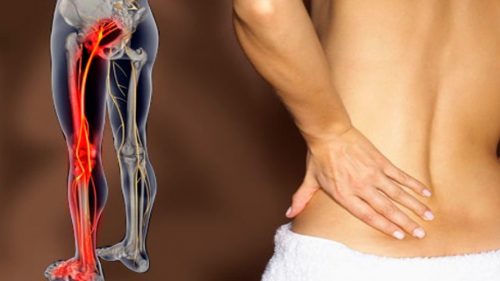
What to do if your back muscles are cold?
Of course, the most natural human reaction in this case is to take a painkiller. But in fact, a person simply does not understand that analgesics in this situation only mask the pain without eliminating its cause. As a result, inflammation can develop further, and over time the pain will become so severe that no painkiller can cope with it. And the consequences for the spine may not be the best. So don’t rush into it; first, you should use other, old and proven methods. Let's figure out what to do if you have a cold back.
Rubbing
One of the oldest, and at the same time, effective methods in such situations when it comes to back pain as a result of hypothermia. Fortunately, now there is no need to turn to old complex recipes, which are now difficult to collect and implement - in pharmacies there are more than enough different rubs, gels and creams with a variety of effects. In this case, you should pay attention to drugs that have not only an analgesic, but also a warming effect. There is no point in providing a list of medications, since they need to be selected individually, because there is always a risk of an allergic reaction to one of the components of the drug. In addition, you must always remember that such drugs are always applied only in accordance with the instructions and only on whole (without scratches, cuts or inflammation) skin. Otherwise, you risk getting an inflammatory reaction and burn instead of a warming effect.
Heat treatment
The natural reaction to hypothermia is to warm up cold muscles. This is, in principle, correct, since heat helps to quickly restore damaged tissue. It is heat that allows you to relax cramped muscles, reduce swelling and relieve inflammation, thereby restoring blood circulation and reducing pain. For such procedures, you can use a heating pad (electric or conventional). A good option is also to use a special pepper patch. Special belts, somewhat reminiscent of a bandage, also give an excellent effect - inside they are lined with insulation made from sheep or, therefore, they warm perfectly.
But in case of severe pain, such active methods of warming should be treated with caution. If the cause of the pain turns out to be, then warming will only do harm. So in this case, it would not be a bad idea to consult a doctor.
PS In the video below you can see which heating pad, rubber or salt, warms your back better:
By the way, you may also be interested in the following FREE
materials:
- Free books: “TOP 7 harmful morning exercises that you should avoid” | “6 Rules for Effective and Safe Stretching”
- Restoration of knee and hip joints with arthrosis - free video recording of the webinar conducted by physical therapy and sports medicine doctor - Alexandra Bonina
- Free lessons on the treatment of lower back pain from a certified physical therapy doctor. This doctor has developed a unique system for restoring all parts of the spine and has already helped more than 2000 clients
with various back and neck problems! - Want to know how to treat a pinched sciatic nerve? Then carefully watch the video at this link.
- 10 essential nutritional components for a healthy spine - in this report you will learn what your daily diet should be so that you and your spine always have a healthy body and spirit. Very useful information!
- Do you have osteochondrosis? Then we recommend studying effective methods of treating lumbar, cervical and thoracic osteochondrosis without drugs.
Sudden back pain
- it's always unpleasant. Especially if you were planning to spend the day with friends or family, go on a trip, or just relax a little at home.
The obsessive pain will constantly remind you of itself, and you will no longer be able to think about anything else.
My first thought is that I have a cold in my back.
. This may indeed be one of the reasons for back pain.
We sat in a draft or under the air conditioner, ran out sweaty into the cold, or completely forgot to warm ourselves enough when going out into the cold.
However, it should be remembered that pain in the back can have a completely different nature and, before starting treatment, you should consult a doctor and make an accurate diagnosis.
Traditional recipes for oral administration
Treatment of inflammation of the sciatic nerve with folk remedies involves the use of infusions and decoctions prepared from medicinal plants. The following recipes have been time-tested.
- 2 tbsp. l. pour 400 ml of boiling water over calendula flowers and leave covered for 2 hours. Take half a glass before each meal.
- Boil 1 tbsp over low heat for 5 minutes. l. chopped burdock root, poured with 1 glass of red wine. Take 100 ml twice a day.
- 2 tsp. horse chestnut seeds pour 400 ml of boiling water and keep in a water bath for 15 minutes. Then strain through a fine sieve. Take 100 ml before meals.
- 1 tbsp. l. Brew chopped elecampane root in 1 cup of boiling water and keep on low heat for 15 minutes. Take for chronic sciatica twice a day, an hour before meals.
- Mix 1 tsp. powder and 1 tbsp. l. hazel leaves, pour 200 ml of water and boil for 10 minutes over low heat. Pass through a strainer or gauze and take 100 ml 4 times a day.
- The salt race method. Includes infusions of rosehip and parsley, as well as watermelon rind powder. Thanks to their diuretic properties, these drugs help normalize metabolic processes, reduce swelling and inflammation of the nerve roots.
In order not to have to turn to such recipes, you need to follow simple rules: do not get too cold, do not lift weights, maintain your posture and take care of your spine, which contains the core of the entire body, its strength and health.
Symptoms of a cold back
Before talking about the symptoms of the disease, you need to briefly describe the list of reasons that can cause it.
Symptoms usually begin to appear after the following factors:
:
- Swimming in cold water
. We all can't resist a cold shower on a hot day. We open the windows in the room (or turn on the air conditioner) and go into the shower, so that during our absence both the room will cool down and we ourselves will take a cool shower. This situation clearly demonstrates a sharp change in temperature, which can lead to the onset of the disease. Even a contrast shower can cause back pain; - Sudden temperature changes. This factor can be combined with the first one, but it also has its own independent influence
. For example, you were in a hot, stuffy room for a long time (or outside in the heat), and then you entered a well-cooled air-conditioned room. This difference has an extremely adverse effect on your health; - Draft
. This factor occurs even in summer. For example, in open spaces (embankments or observation decks) the wind blows cold and piercing. This can only bring a cold to a hot body; - Clothing inappropriate for weather conditions
. Girls in short skirts and nylon tights (or even without them at all). You definitely need to cover your lower back, otherwise you won’t be able to avoid problems later.
Symptoms begin to appear 12-13 hours after exposure to one of the presented factors
.
The main symptoms of a cold back are
:
- Acute pain in the part of the back where the thoracic region passes into the lumbar region. Pain occurs only when moving;
- The patient is constantly forced to take a constrained position, allowing him to somewhat relieve the pain;
- There is burning and itching in the area of cold muscles;
- Your temperature may rise;
- The skin color on the back takes on a bluish tint;
- There are cases of loss of sensitivity and numbness;
- In girls and women, the menstrual cycle is disrupted;
- Pain sensations spread to the buttocks and legs;
- Frequent urination;
- Nausea;
- Loss of appetite.
Video: “Myositis of the back muscles”
Radiculitis
If treatment for osteochondrosis is started, radiculitis may begin to develop. The causes of the pathology can be different:
- diseases of internal organs;
- improper development of the spine;
- hypothermia;
- heavy loads on the spine;
- infections;
- sedentary lifestyle.
In the presence of radiculitis, severe sharp pain occurs in the lower back, which can lead to paralysis or complete loss of sensation in the legs. Treatment must be individualized and consist of a set of procedures. Symptoms of a cold lower back in men may differ from those observed in women, so if you feel unwell, it is recommended to consult a doctor.
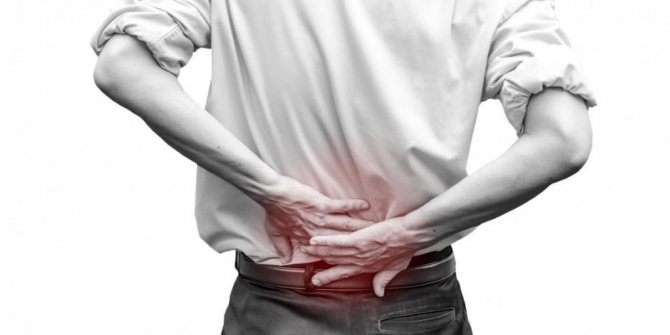
Pathogenesis of a cold back
The mechanism of development of the disease depends primarily on the reasons that provoked it.
. The pathogenesis of a cold back is associated with the effects of low temperatures on a certain area of the back. A muscle that has been exposed to hypothermia begins to swell, which leads to discomfort and then pain in the patient.
The further the disease develops, the more irritated the nerve endings will be.
located in the inflamed area, inflammation and swelling of the spine and nearby tissues may begin. All this can develop into a process of active compression of the nerve roots of the vertebrae and the development of more serious spinal diseases.
Consequences of a cold back
If you were somehow able to survive back pain, loss of mobility and muscle swelling, and did not treat your cold back, then you should find out what consequences this will lead to
:
- The inflammatory process, previously localized in one area, will begin to spread to neighboring ones, up to the involvement of internal organs in the process;
- The process of muscle tissue atrophy will begin, up to complete loss of performance;
- The respiratory process and swallowing process will be disrupted;
- Ossification of muscle tissue will occur;
- If the main blow falls on the cervical spine, then disturbances in the ENT organs are possible, as well as an increase in the load on the cardiovascular system;
- A secondary infection may occur and the development of purulent myositis (for example, abscesses and phlegmon).
Video: “What to do if your back hurts?”
Types and treatment of neuralgia
If a person has a cold on his nerve, pain and vegetative manifestations will immediately indicate the development of the inflammatory process, i.e. increased sweating, hyperemia, myalgia, etc. The most common types of neuralgia are:
- trigeminal – inflammation of the trigeminal nerve;
- intercostal – compression of the spinal nerve roots;
- occipital – damage to the occipital nerve;
- radial and ulnar – compression of nerve bundles located in the arms.
If any of the above types of neuropathy develop, the following general symptoms are observed:
- hyperthermia;
- marbling of the skin;
- irritability;
- fast fatiguability;
- pain at the location of the affected nerve roots.
If a person has a cold in the occipital nerve, he will face severe headaches. Their appearance is caused by compression of the nerve roots by surrounding tissues.
If left untreated, the pain becomes permanent, and any head movements provoke nausea and dizziness.
The causes of occipital neuropathy include:
- muscle strain;
- endarteritis and gout;
- diabetes mellitus and osteochondrosis;
- injuries and hypothermia;
- infectious diseases (meningitis, encephalitis).
The main symptoms of a cold nerve will be:
- headache;
- “lumbago” in the lower part of the neck;
- increased pain when turning the head;
- sensitivity to bright light;
- hypo-hypersensitivity of the skin.
In most cases, entrapment of the trigeminal nerve on the face is due to the following reasons:
- multiple sclerosis;
- hypothermia;
- malocclusion;
- muscle strain;
- vascular aneurysms;
- viral and bacterial infections.
If a person has a cold in the jaw nerve, the development of the inflammatory process will be signaled by:
- pain while chewing;
- numbness in the lower part of the face;
- increased salivation;
- involuntary contraction of the jaw muscles;
- skin hypersensitivity.
The hand is innervated by several nerve bundles, but in the case of negative effects of exogenous and endogenous factors, the radial, median and ulnar nerves most often suffer. The main causes of pathology include:
- hormonal imbalances;
- infectious diseases;
- vascular disorders;
- injuries;
- thyrotoxicosis;
- physical stress;
- deformation and inflammation of the ligaments in the hand.
The following symptoms indicate a cold in the nerve of the hand:
- sharp and aching pain in the shoulder and arm;
- swelling of the affected limb;
- partial paresis;
- limited limb mobility;
- numbness of fingers;
- decreased hand sensitivity;
- increased pain with muscle tension.
Between the 12 pairs of ribs there are a large number of nerve endings. If the peripheral nerves are pinched in the thoracic region, severe pain occurs under the scapula. If the clamping occurs on the left side, the symptoms of a neurological disease are often confused with pain in the heart. The causes of inflammation of nerve endings can be:
- osteochondrosis and compressor fracture;
- hypothermia and hormonal imbalance;
- lung disease and anemia;
- multiple sclerosis and diabetes mellitus;
- scoliosis and kyphosis.
What symptoms indicate inflammation if a person has a cold on the nerve under the scapula?
- pain in the thoracic spine, radiating to the neck or lower back;
- impaired sensitivity of the skin at the site of inflammation;
- burning and itching in the area of the shoulder blade;
- increased pain when sneezing, coughing and moving.
Is it possible to warm a cold nerve? Experts do not advise self-medication, as this can only worsen the course of the disease.
Dry heat is used in the treatment of neuropathy, but in the absence of abscesses in the affected tissues.
Warming up of purulent foci of inflammation provokes the development of a bacterial infection, which can provoke severe complications including paralysis.
Physiotherapeutic procedures, medications and surgery are used to eliminate the disease. Conservative treatment of a cold nerve is accompanied by taking the following medications:
- antibiotics;
- analgesics;
- antidepressants;
- multivitamins;
- muscle relaxants;
- anti-inflammatory drugs.
How to cure a cold nerve? To quickly block inflamed nerve bundles and treat them, the following types of medications are used:
- "Sirdalud" is a muscle relaxant, the components of which act on skeletal muscles, promoting its relaxation;
- Finlepsin is an anticonvulsant drug that eliminates muscle spasms. Has anti-inflammatory and analgesic effects;
- Cymbalta is an antidepressant that is used in the treatment of peripheral neuropathy. Eliminates irritation and promotes normal sleep;
- "Sulindac" is a non-steroidal anti-inflammatory drug that accelerates the process of regeneration of nerve fibers;
- "Metypred" is a glucocordicosteroid hormone that promotes the synthesis of lipocortin, which reduces inflammation.
conclusions
How to treat a cold nerve?
Neuropathy in 90% of cases is accompanied by severe pain in the affected areas of the body. Timely treatment helps prevent tissue abscess and complications.
To eliminate neuralgia I use antidepressants, multivitamins, antibiotics and analgesics. They relieve symptoms of neuropathy and promote decompression of nerve roots.
Treatment for a cold back
You shouldn’t hesitate to treat a cold back. After all, unpleasant symptoms interfere with normal existence, and the consequences of this disease are quite serious.
First aid
If the disease takes you by surprise and there is no opportunity to resort to complex treatment, then you can provide first aid to yourself, relieve the main symptoms, and then begin the main treatment of the disease.
So, what to do if the illness caught you unexpectedly?
:
- Bed rest is mandatory
. For several days, no physical or emotional stress, only peace, quiet and warm tea; - Lubricate the inflamed area with warming ointments or gels
. Always try to keep this type of medicine in your first aid kit, for example, fastum-gel or finalgon. Such drugs relieve muscle spasms, improve blood circulation and relieve inflammation. It is advisable to treat diseased areas at night for 10 days. After you have applied the ointment or gel, thoroughly insulate your back; - When the main peak of the exacerbation subsides and you are able to go outside and move normally, always remember that a relapse can happen at any time, so wear warm clothes when leaving the house
,
do not take too hot baths
,
do a relaxing massage
, and
follow a diet
.
Drug treatment
Did you know that...
Next fact
Most medications are aimed at reducing or eliminating pain caused by hypothermia of the back.
All medications are divided into several main groups:
- Anti-inflammatory drugs.
This group includes drugs from the NSAID group, for example, ibuprofen, ketorol, ortofen. These medications are aimed at reducing inflammation and easing pain; - Muscle relaxants.
These drugs are designed to combat muscle spasms. They are usually used together with anti-inflammatory drugs (antispasmodics); - Painkillers.
Unlike anti-inflammatory drugs, these drugs do not relieve the inflammatory process, but only relieve pain (analgesics).
It is not advisable to take medications on your own. Consult with your doctor, only he will be able to correctly select a list of medications for you that will effectively eliminate all the symptoms of the disease. Ointments and gels based on NSAIDs are also used. They should also be chosen on the advice of a doctor.
Therapeutic massage and physiotherapy
For a cold back, physical therapy is a good strengthening measure. In combination with massage, it can also be a separate therapeutic measure, not supported by medications. A minimum of medications means a minimum of side effects, no allergic reactions and strengthened immunity. The main thing is that both physiotherapy sessions and massage sessions are carried out by a professional.
Physiotherapy
Physical therapy can be a good help in treating a cold back
. The main thing is to remember: exercises should be started only when the crisis has passed and the main pain syndrome has subsided. If you are at the “bed rest” stage, then any physical activity is out of the question.
Here are some general strengthening exercises you can do:
:
- Lie on your stomach so that your body forms a straight line. Now start doing backbends like a cat. You need to tilt your head up as much as possible in your case. Repeat the exercise 8-10 times;
- Lie on your back, on a hard surface, bend your left leg at the knee. Now pull your leg towards your chest and try to stay in this position for a few seconds. Do this exercise for each leg in turn (8-10 times);
- Lie on your stomach, put your legs together and stretch them out. Bend your elbows and begin to lift your upper body, as if you are trying to reach some imaginary object.
Warming up
- It is believed that warming up a cold back helps a lot. First, rub your back with a warming ointment or gel
, and then apply a warming compress or heating pad (you can take a regular medical bladder and fill it with hot water); - In addition to a heating pad, you can use a folk remedy
: heat regular table salt in a frying pan, pour it into a sock and use this sock as a heating pad; - also have an excellent warming effect
. But their downside is that they are very irritating to the skin, so if you have sensitive skin or have any damage or irritation on the skin, it is better to abandon the idea of mustard plasters.
Folk recipes
Among the folk recipes you will find many that will help with a cold back. The main thing is to choose wisely, rely on the characteristics of your body.
Here are some of the most effective folk methods for treating back colds:
:

Why does a nerve become pinched?
For what reason does pinching occur, and why specifically in the shoulder blade? After all, there are nerves throughout the spine. This is true, but it is in the thoracic area, where the shoulder blades are located, that the nerves are most susceptible to various influences. Second in line is the back, which is supplied with lumbar nerves. A person may also experience pain in the shoulder, collarbone and neck when the nerves of the cervicothoracic area are pinched.
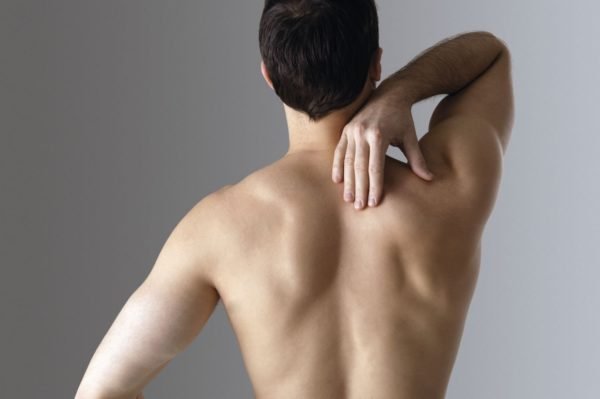
Pain may radiate to the neck
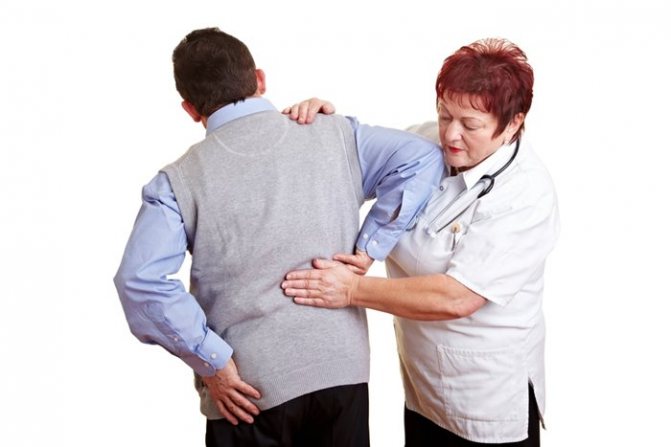
This diagnosis is noteworthy in that a person often makes it himself, saying that a nerve is pinched, and a compress or poultice at home, without bothering to see a doctor, or it will go away on its own. And in most cases, especially if the scapular nerve is inflamed due to hypothermia, the pain actually begins to subside the very next day.
Prices for painkillers for back pain
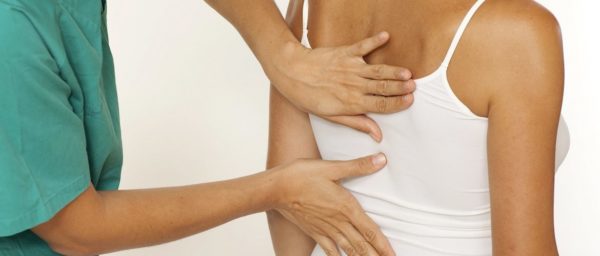
The cause of the pain must be determined by a doctor
It’s worth starting to understand the problem with the question: how does pinching occur? It occurs due to the fact that the nerve is compressed by the tissues surrounding it. This can be bone or cartilage tissue, muscle or tendon tissue. For this reason, pain can occur at any spinal level.
The disease is spread throughout the body and occurs in a large percentage of patients, but as such there is no diagnosis of “pinched nerves”. This is because it is not a disease, but only a symptom of it. And not even one, but many diseases. This is why diagnosis is important to identify the cause of the pinched nerve.
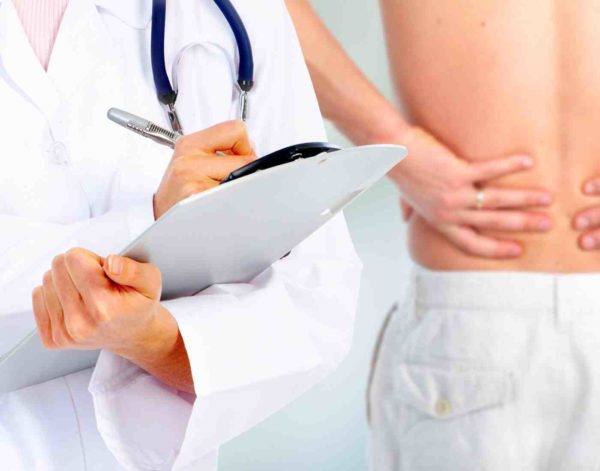
It is important to undergo an examination and find out the cause of the pinched nerve.
Why a nerve may become pinched:
- due to injury;
- due to tumor;
- a growth forms on the bone tissue;
- the patient leads a sedentary life;
- he experiences excessive stress;
- there is an intervertebral hernia;
- osteochondrosis is present;
- hypothermia occurs;
- disc protrusions are formed;
- this is a consequence of arthrosis;
- the patient has arthritis;
- gastrointestinal diseases;
- there are diseases of the endocrine system;
- tumor-like formations;
- history of an autoimmune disease.
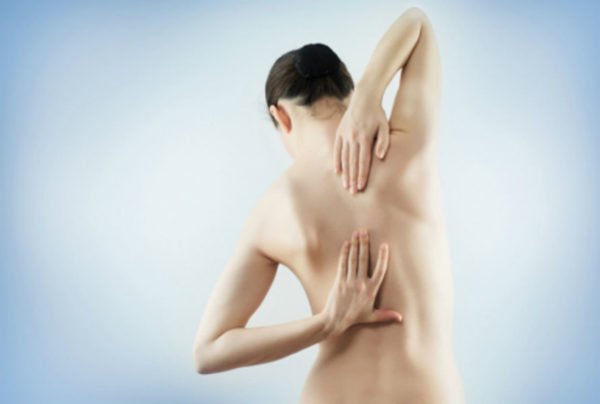
The nerve can be pinched due to herniated discs, as well as for many other reasons.
As you can see, there are many reasons for a nerve to be “pinched.” There are also indirect accompanying circumstances that will help or provoke the process. Excess weight and old age, damage to posture and hereditary factors, as well as pregnancy, are called provoking factors.
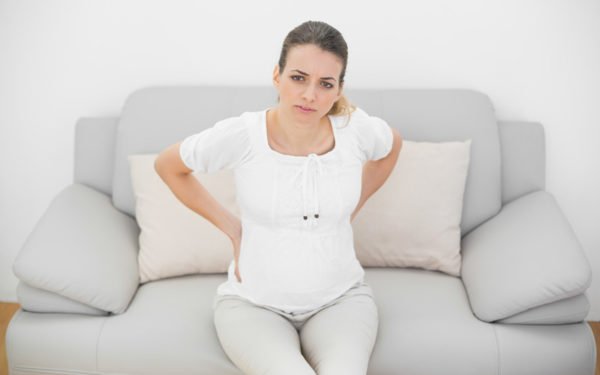
Nerves can become pinched during pregnancy
The following can directly cause an attack of pain from a pinched nerve:
- lifting weights, if you do it abruptly or take significant weight;
- a certain position that is not comfortable that a person takes during sleep;
- sleeping on a mattress that is too hard/soft or of poor quality;
- being in a draft, wind, or low temperatures;
- overeating with existing obesity;
- injury to the back or chest.
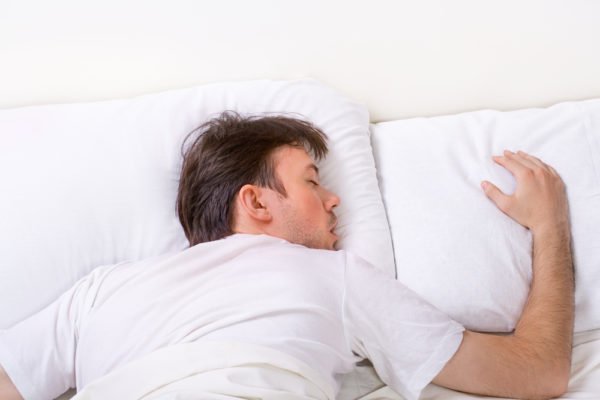
A nerve may be pinched due to an uncomfortable posture during sleep.
These reasons are secondary. And, unlike the list of reasons given above, they are much easier to deal with. In a short time it is possible to return to your normal life and stop experiencing pain. If the problem is a disease, then the patient must undergo long-term complex therapy so that pinching does not recur.
My back is blown, how to treat it?
Many people are interested in how to treat if they have a cold back.
- 1. First of all, you should apply warming ointments for the back: apizartron, capsicam, viprosal, finalgon. They help warm up the muscles and relieve muscle spasms. However, it should be borne in mind that ointments are not acceptable for anti-inflammatory purposes for the lumbar and thoracic spine. After all, the inflamed disc is located very deep, and the ointment simply cannot penetrate it and have the necessary effect. The depth of penetration of the ointment can be increased using ultrasound. For the best effect of the ointment, the sore spot should be massaged well and then the ointment should be applied. The gel has greater penetrating power compared to ointment. You can also rub your back with camphor alcohol and wrap it with something warm on top.
- 2. Before going outside, you need to dress for the weather.
- 3. If the pain is severe, consult a doctor. As a rule, in such cases injections are prescribed. For example, Movalis ampoules, which can relieve back pain.
- 4. Wear a warming belt for your lower back.
Back pain may occur due to muscle spasms caused by cold. In such cases they say “I got a cold in my back” or “I got a cold in my back.” As a result, you cannot bend, straighten, or turn. It seems that you are aching all over.
In this case, you must follow the following recommendations.
- 1. Place the patient on a hard surface and give an anesthetic. This could be analgin or spasmolgon.
- 2. To prevent pain from getting worse, do not sit in a hot bath.
- 3. You can use a dry heating pad. If it does not help, rub any back ointment into the lumbar area that suits you and does not cause allergic reactions. For example, butadiene or indomethacin new ointment.
- 4. It is necessary to limit the intake of salt and liquid in your diet.
- 5. Bed rest must be observed for at least three days.
If as a result of all these actions there is no improvement or, on the contrary, the pain intensifies, then you should call a doctor at home to prescribe appropriate treatment.
Drug therapy
If you have a cold back, the main medications that can be treated at home are:
Warming ointments
As irritants that distract from pain with a burning sensation at the site of application. These drugs are available in ointments and gels:
Almost all warming ointments cannot be used by pregnant women at any stage. Also, you should not apply these gels and ointments to the kidney area.
It is necessary to provide warmth for the affected area: a blanket, a scarf, a blanket, a woolen belt, a heating pad of moderate warmth (after placing a cloth).
NSAIDs – non-steroidal anti-inflammatory drugs
These drugs relieve pain and reduce the inflammatory response. They can be used both topically and orally:
Local forms that can be applied to the skin of the affected area of the back. These remedies are suitable if the pain is not very intense:
- Ketoprofen (50 r.), Artrosilene gel (200 r.), Bystrum gel (150 r.), Ketonal (200 r.), Fastum gel (200 r.), Flexen (150 r.), Febrofid gel (200 r.).
- Nise and Nimulid (120 rubles).
- Diclofenac, Diclovit (80 rub.) and Voltaren (250 rub.), Diclak (180 rub.), Diclogen (40 rub.), Dicloran (100 rub.), Diclofenacol cream (40 rub.), Ortofen (40 rub.).
- Piroxicam Verte (90 rubles) Finalgel (360-420 rubles).
- Ibuprofen (30 rubles), Dolgit (100-220 rubles), Nurofen gel (140 rubles)
- Butadion (120 rubles)
Systemic - in the form of tablets or injections. They have a stronger effect because they immediately enter the bloodstream:
- Diclofenac 40 rub. (Voltaren 200 rub., Ortofen 20 rub., Diklak 100 rub.)
- Ketolorac 60 rub. (Ketanov, Ketarol)
- Nimesulid (Nise 140 r. Nimulid, Nimika)
- Ketoprofen (ketoprofen 150 rubles, Bysrumkaps 270 rubles, Flexen 170 rubles), injections: Arthrosilene (6 pcs. 180 rubles) Ketonal (10 pcs. 200 rubles) Flamax (5 pcs. 100 rubles). Flexen (6 pcs. 270 rub.) Meloxicam 40 rub., Movalis 250 rub. Amelotex (amp. 280 RUR) Arthrozan (amp. 190 RUR).
- 20 rub. (Nurofen 110 rub., Faspik 100 rub., Burana 80 rub.)
Nimesulide and Meloxicam are safer for the mucous membrane of the gastrointestinal tract: they are less likely to cause damage in the form of erosions and ulcers. In any case, such drugs should be taken under the guise of their analogues (Omez, Gastrozol, Ultop, Ortenol, etc.).
Muscle relaxants
As a supplement, muscle relaxants are suitable - medications that relax muscles, not just the back. These include:
- Tolperisone (400 rub.), Tolperisone 200 rub.
- Tizanidine 200 rubles, Sirdalud 300 rubles, Tizalud 140 rubles.
B vitamins
If prescribed by a doctor, you can give injections with combination preparations containing vitamins B1, B6, B12. They have a moderate analgesic effect (especially vitamin B12). As well as a positive effect on processes in the nervous system, on metabolism, they participate in the transmission of excitation, in the metabolism of mediators, and contribute to the restoration of damaged nerves. These include:
- Milgamma (5 amp 280 RUR)
- Combilipen (5 amp. 160 RUR)
- Neurobion (without icecaine 3 amp. 270 RUR)
- Compligamv (160 rub.)
Novocaine blockades
In severe cases of severe back pain, the doctor may prescribe novocaine blockades if the patient has no contraindications to the use of hormonal drugs. Novocaine with a corticosteroid drug is injected into the inflamed back muscles.
Back muscle inflammation
Back muscle inflammation is an inflammation of a muscle or muscle fibers that results in the formation of nodules within the muscle. It is also called the term myositis.
Symptoms of myositis:
- 1. Pain that intensifies with movement or palpation.
- 2. Muscle atrophy.
- 3. Redness and swelling of the skin.
- 4. The occurrence of muscle pain.
Causes of myositis:
- 1. Past infectious diseases.
- 2. The influence of toxic substances.
- 3. Muscle strain.
- 4. Muscle cramps.
- 5. Helminths.
- 6. Hypothermia.
Treatment for this disease is prescribed individually depending on the causes of inflammation of the back muscles.
